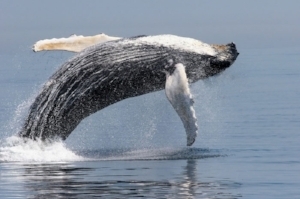Humpback Whales Celebrate World Ocean Day 2018
From the flying bridge of the 67-foot NOAA research vessel Fulmar, the marine sanctuary researcher peered through powerful binoculars and called out, “Humpback whales … four … milling …” as another scientist entered the data into the laptop. Sea conditions were decent, especially for a springtime survey, when brisk winds and rough seas can result in “blow-out” days. Underway at 0630 from Sausalito, they’d made their way offshore, encountering several whales just outside the Golden Gate. Later that week the team would survey the Mendonoma coast, “running transects” – straight, pre-set lines – to gather information on how much food the ocean was producing – as evidenced through plankton tows, but also by the presence of feeding whales, seabirds and other marine life. Humpbacks tend to be the most often-seen whales, along with blues and sometime fin whales. Today was shaping up to be a busy one. This information will be shared and used to help marine conservation, to restore ecosystem health. “News you can use.”
Humpbacks are denizens of the world’s oceans, from the Arctic to the Antarctic and nearly everywhere in between. Those who have seen humpbacks can understand why they make such outstanding “ambassadors of the sea” – with their size, and elegantly long pectoral fins – their name, Megaptera novaeangliae, actually means “Long-winged of New England.” Also, their sheer exuberance and awe-inspiring acrobatics: breaching, fin-slapping, tail-lobbing; and their elaborate and sophisticated songs. Herman Melville termed humpbacks “the most gamesome of whales.” (And who’s going to argue with Melville?!)
Their recovery from the carnage of whaling, which international legal protections ended in 1966, is at the rate 7-8% per year. Our California-Oregon-Washington “Distinct Population Segment” – i.e., the humpbacks in the hood – numbers approximately 1,918 animals. In 1986, Greater Farallones National Marine Sanctuary provided the seed funding for humpback whale research in the region to Cascadia Research Collective. Cascadia has built upon these first three critical years of research to create one of the best studies of whale populations in the world.
A curious outcome of their increase is that when humpbacks reached their historic numbes regionally in 2012, they began to re-populate nearshore and estuarine feeding grounds. They’re now visible from land along the coast, and in San Francisco Bay and Puget Sound. This has brought them into greater conflict with shipping, recreational boaters, fishing operations, and higher noise levels. Shipstrike and entanglement are taking a toll, but agencies such as the National Oceanic and Atmospheric Administration and its marine sanctuaries, the shipping industry, fisheries and scientific groups are working together to reduce these threats. Still, most humpbacks in our waters remain on the Endangered Species List, despite their growing numbers; mostly due to threats that still face them.
On June 8 we celebrate World Oceans Day, and the humpbacks’ recovery is a beautiful reason to celebrate. The oceans are the lungs of our planet, providing most of the oxygen we breathe. They are a major source of food and medicines and a critical part of the biosphere. It is a day to celebrate, together, the beauty, wealth and promise of the ocean, and to work toward making ours a sustainably managed planet.
This year’s theme is preventing marine debris through reducing plastic use. Think about it: one material, one world ocean. Admittedly, plastic is a part of our lives, from packaging, to household goods, to computers and pacemakers. The trick is to live with it responsibly. Reduce its use when alternatives are available. Dispose of it responsibly by recycling, or get creative and “re-purpose” it. Through these simple actions, and a deepened understanding of how we are part of this blue planet, each of us can honor the ocean and its creatures every day.
NOTE:
Photo Credits (all): Top Left: Humpback Breaching. Credit: NOAA; Top Right: R/V Fulmar. Credit: CBNMS/NOAA; Middle Right: Echelon-feeding humpbacks. Credit: CSCAPE/NOAA; Lower Left: Upward-lunging humpbacks Credit: Bill Keener/Golden Gate Cetacean Research.
------------
Look for the author at Discover the Coast in Point Arena Saturday, June 9th, and meet research staff at the Farallones’ Beach Watch station on the Lighthouse trail!
###









